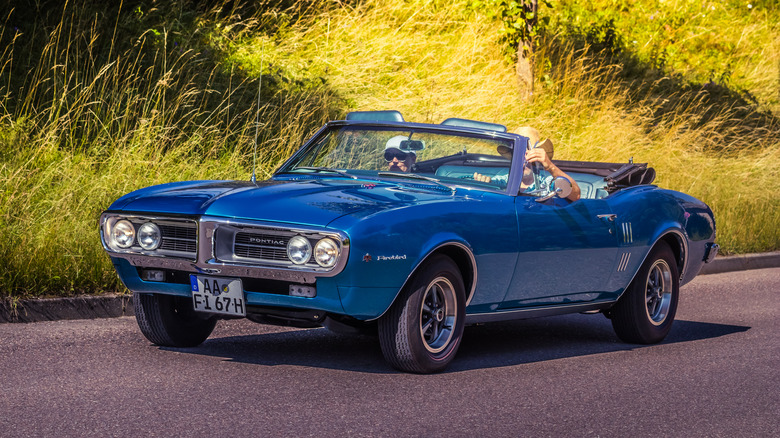
Gaschwald/Getty Images
Pontiac is credited with turning the key on the muscle car era with the legendary 1964 GTO, and by the time the GTO’s first generation ended in 1967, the Ford Mustang was three years old and had sold more than 1.5 million units (via CJ Pony Parts). That year, Pontiac sent the brand new Firebird to dealerships for the first time, and — like the Mustang — it was an instant hit, with 82,560 Firebirds heading out to new owners. Although Ford sold more than five times that many Mustangs in 1967, the first-year Firebird sales came close to matching those of the Mustang in its inaugural model year.
When it came to performance, the 1967 Firebird left the Mustang choking on its exhaust fumes. The debut edition Firebird came with four engine options. The base 230 cubic inch I6 made 165 horsepower and was a full 30 cubic inches larger and 45 horses stronger than the ’67 Mustang’s straight six engine. The 1967 Firebird was also available with a 326 or 400 cubic inch V8. Each could be purchased with the L67 Ram Air intake package, which when placed atop the 400 lifted the redline to an ear-splitting 5,200 rpm and boosted horsepower to 335. The biggest engine available in that year’s Mustang was a 390 inch V8 that made «only» 320 horsepower.
Pontiac’s marketing team took a direct shot at the Mustang
Pontiac almost called the Firebird the Banshee, but after product planner Ben Harrison discovered that a Banshee was a mythical figure from Irish folklore that predicted impending death, the name was wisely changed. In a TV commercial for the 1967 Firebird, Pontiac took direct aim at the Mustang and Plymouth Barracuda. «Horses are nice. Fish are fun, sometimes,» the narrator read over images of a horse languishing in a stall and a dead barracuda on a beach. «But for a road machine that really flies, get a Firebird.»
The ’67 Firebird 400 could fly from 0 to 60 mph in six seconds and cover a quarter mile in 14.7. That was more than a second faster from 0-60 and a half second quicker over the quarter mile than that year’s Mustang. The Firebird 400 also came with a heavy-duty suspension, radiator, and starter; the option list included power steering, brakes, and windows. Buyers could also get an electric top on convertibles, Rally gauges and wheels, and a remote trunk release for those rare moments when the Firebird wasn’t in motion. It was offered in 15 colors: three shades of blue, two hues of turquoise, red, burgundy, plum, green, gold, ivory, silver, champagne, black, and cream.